|
2013 concerts january 25-27, 2013 - san francisco tape music festival april 6, 12 & 14, 2013 - west edge opera: bonjour m. gaugin april 16, 2013 - tinnitus insect volume knobs + paul hoskin april 30, 2013 - tom nunn, bran()pos, matt ingalls may 14, 2013 - christopher burns, bill hsu, iannis xenakis, charles boone, monica scott, matt ingalls may 28, 2013 - maggi payne, john ingle, edgard varèse june 11, 2013 - luciano chessa + benjamin kreith june 25, 2013 - grosse abfahrt with torsten müller & alfred harth july 9, 2013 - andrew claussen & michal rataj july 23, 2013 - boris baltschun + serge baghdassarians & phill niblock august 3, 2013 - sfSound performs penderecki and berio (opening for the sun ra arkestra) august 6, 2013 - goggle & john ingle/kjell nordeson duo august 13, 2013 - $Ɛ∨ƐR!ℵƐ ℬa||0∩ & dan joseph/andrea williams august 27, 2013 - seth cluett & sfSound performing beyer/tenney/dresher september 10, 2013 - san francisco tape music collective september 20, 2013 - elliott carter, in memoriam october 8, 2013 - hadley mccarroll/janis mercer & kyle bruckmann/james fei october 15, 2013 - quinteto latino latin american chamber music festival october 20, 2013 - sfSound @ sfmusic day october 22, 2013 - john krausbauer, alvin lucier, james tenney, phill niblock november 5, 2013 - helmut lachenmann's dal niente & andrew raffo dewar's ekphrasis suite november 19, 2013 - alfonso alberti december 7, 2013 - david coll/kim anno/sfSound december 17, 2013 - morton feldman and christopher jones |
|
|
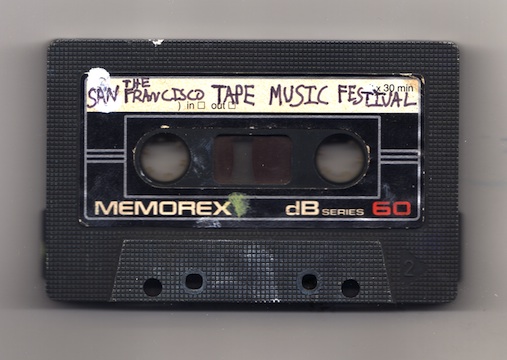
The San Francisco Tape Music Festival 2013 America's only festival devoted to the performance of audio works projected in three-dimensional space, with three distinct evenings of classic audio art and new fixed media compositions by 25 local and international composers. Hear members of the SF Tape Music Collective, along with guest composers, shape the sound live over a pristine surround system consisting of 16+ high-end loudspeakers while the audience is seated in complete darkness. It's a unique opportunity to experience music forming - literally - around you. |
|
|

Bonjour M. Gaugin sfSound collaborates with West Edge Opera and KUNST-STOFF Arts in the American Premiere of Fabrizio Carlone's opera based on Paul Gauguin's life. Gauguin's own words are used as libretto with Carlone's beautiful music that evokes Debussy. Gauguin exists in a world of art where he communicates with his own inner voice, sung by soprano Shawnette Sulker. |
|
|
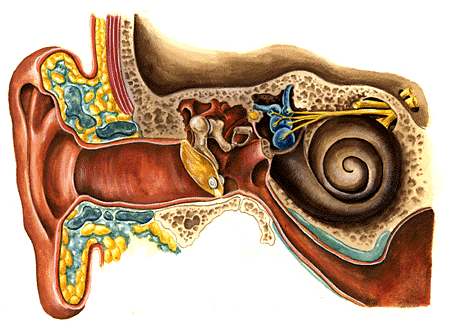
The High and Low – Tinnitus Insect Volume Knobs + Paul Hoskin and friends The High (and Low): A project of sfSound, Tinnitus Insect Volume Knobs is an ensemble/composition that explores the psychoacoustic phenomena of “difference tones”. When two tones are played simultaneously, listeners can perceive an additional tone whose frequency is a sum or difference of the two frequencies. By performing only closely-tuned pitches above 1000Hz, the resulting synthesized difference tones are in a clearly lower audio range. In a reverberant space such as the Center for New Music, the acoustics only contribute to this effect. Hard to reproduce over recordings, listeners often perceive the (harmless!) difference tones as originating from inside the ear. Performers include John Ingle, Phillip Greenlief, Jesse Canterbury, Kyle Bruckmann, and others. The Low (and High): With a pitch range down to 29Hz, the contrabass clarinet can indeed play low, but the instrument also lends itself to some of the most complex multiphonics of any wind instrument. Paul Hoskin, who has been on the improv scene since late 80's, has taken “multiphonic improvisation” on the instrument to new heights. His sonic explorations will be matched with local virtuosi Ken Ueno (extended vocals), Matthew Goodheart (extended piano), and Matt Ingalls (extended extensions). Paul Hoskin began playing contrabass clarinet in the summer of 1985. Utterly self-taught, his reed playing life started in the fall of 1980—c melody saxophone, then clarinet, and the bass clarinet exclusively by the spring of 1981. Baritone saxophone added in the spring of 1984. Hoskin performs (and performed) extensively throughout the United States and Europe. Paul’s solo oeuvre is initiated in Seattle June 1986. The fall of 1986 finds himself in Eastern Europe—seven solo performances in twelve days. As solo language develops, Hoskin begins the extended contrabass clarinet work. Ninety minutes continuosly (a switch of technology commands its current eighty minute form). The growth and definition of his solo work is part and parcel of the decade of music life in New York City (1986-1995). Three different ensembles (The Same, Trigger, Dierker/Meehan/Hoskin) provided Hoskin with musics of many sorts. Paul’s life as an organizer for an improvised music community is also shaped. Seattle is returned to in 1996. And, solo language, multiple creative ensemble work, endless ad hoc meetings are resuscitated. Different people, different coast. A brief stay in Astoria, Oregon (2006-2009) reinvigorated the organizer chunk of his work. And, fortunately, the Oregon chapter managed to put Paul in touch with the Bay Area creative music world. |
|
|
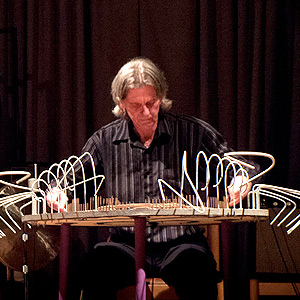
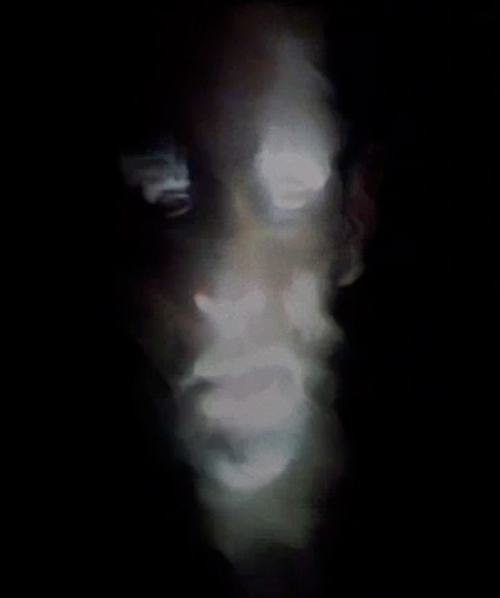
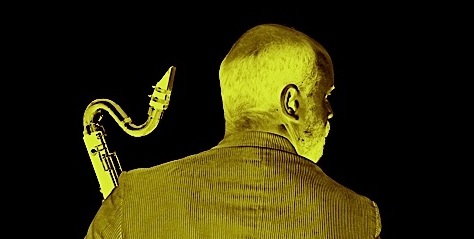
The Art of One An Evening of Solo Performances by Tom Nunn, bran(…)pos, and Matt Ingalls An evening of solos by by three wildly different, yet equally engaging bay area performers: Tom Nunn performs improvisations on his original instruments; bran(…)pos performs a piece for mouth, synth, face, and live video; and Matt Ingalls performs his decades-in-the-making clarinet solo that explores extended techniques that interact with the acoustic space. Free improviser and instrument builder Tom Nunn has designed, built and performed original musical instruments since 1976. His instruments (over 200 to date) typically utilize commonly available materials (metal sheets, nails, balloons, steel and bronze rods, combs, etc.) and are sculptural in appearance. They are amplified using contact microphones and are designed specifically for improvisation with elements of ambiguity, unpredictability and nonlinearity. But what is most unique about this instrument builder, is that Tom Nunn has the dedication and musical talent to learn and master his instruments. His performances are just as enjoyable for their music as they are for their instrumental design. bran(…)pos is the ongoing audio-visual-performance-noise-musique-brain-bend of Jake Rodriguez from San Francisco. Rodriguez has been performing and recording under this moniker for 15 years with releases on C.I.P., Resipiscent, Ratskin Records, Animal Disguise, and Chitah! Chitah! Soundcrack. Synthesizer and mouth manipulations are the most common audio elements, rounded out with rubber face and a live video component to complete the human-analog-digital-human circle. “With a background in theater performance and sound (and a seriously demented mind), Rodriguez with his bran(…)pos project has boiled down the most absurd elements of our ongoing ritual into an amalgamation of human, sound, and light that is at once ridiculous and terrifying.” Reviled for his “shapeless sonic tinkering” by the Los Angeles Times, Oakland musician Matt Ingalls is a composer, clarinetist, concert producer, and computer music programmer. Often incorporating elements of improvisation, his music is heavily influenced by his long involvement in computer music. His composerly solo improvisations explore extended clarinet techniques that interact with the acoustic space, often as combination tones. Matt is the founder and co-director of sfSound, a new music series, ensemble, and internet radio station devoted to new ideas and traditions of experimental music, performance art, live electronic music, Bay Area composition, and the various facets of contemporary improvisation. |
|
|
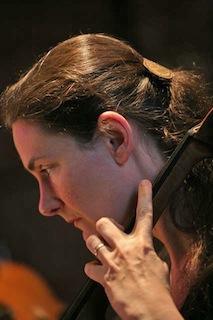
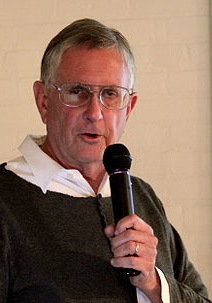
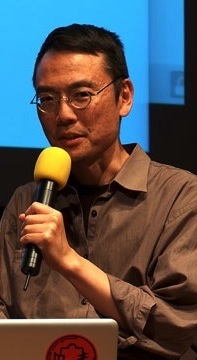
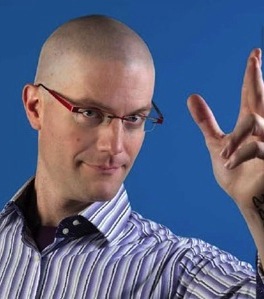
Xenoglossia/Leishmania (Christopher Burns and William Hsu) & music by Iannis Xenakis, Charles Boone, Monica Scott, and Matt Ingalls Xenoglossia/Leishmania is a structured audiovisual improvisation, featuring live electroacoustic music by Christopher Burns and interactive animations by William Hsu. Their musical and visual performances are highly interdependent, guided together not only through the actions of the performers, but also through automated real-time audio analysis and the exchange of networked data. Burns' Xenoglossia audio software is designed to facilitate the creation of complex, densely layered music with an emphasis on trajectory and directionality. The performer initiates multiple simultaneous musical layers, each with distinct gestural and textural content, then controls their continuation and development. Hsu's Leishmania is an interactive animation environment that visually resembles colonies of single-cell organisms evolving and "swimming" in a fluid substrate. Protean, organic-looking shapes emerge and evolve in the system in a highly unpredictable manner; the colonies alternately congeal into relatively well-defined forms, or disperse into chaos. Together, music and visuals produce a richly textured, complex and immersive experience. Rounding out the program, sfSound's Monica Scott premieres a new work for cello and electronics by Charles Boone and performs Iannis Xenakis's Charisma and a new collaborative work with clarinetist Matt Ingalls. William Hsu is an Associate Professor of Computer Science at San Francisco State University. His current research interests are in high-performance processor and memory system architecture, performance evaluation, and interactive computer music. He received his PhD from the University of Illinois. Hsu works with electronics and real-time animation systems that have some of the live, tactile qualities of good human musicians playing acoustic instruments. His work mostly involves using gestural interfaces to control animation and sound s=0ynthesis, and real-time audio-visual systems that interact with human performers. Christopher Burns is a composer, improviser, and multimedia artist. His instrumental chamber works weave energetic gestures into densely layered surfaces. Polyphony and multiplicity also feature in his electroacoustic music, embodied in gritty, rough-hewn textures. As an improviser, Christopher combines an idiosyncratic approach to the electric guitar with a wide variety of custom software instruments. Across all of these disciplines, his work emphasizes directionality, layering and intercutting a variety of trajectories to create form. Christopher teaches music composition and technology at the University of Wisconsin-Milwaukee. Charles Boone studied at the Akademie für Musik und darstellende Kunst in Vienna, the University of Southern California, and San Francisco State College. Karl Schiske, Adolph Weiss, and Ernst Krenek were among his teachers. He has been awarded three National Endowment for the Arts Commissions as well as a two-year Deutscher Akademischer Austauschdienst (DAAD) artist-in-residency in Berlin. His works have been performed by the San Francisco Symphony, the Chicago Symphony, and the Los Angeles Philharmonic, as well as the Berlin, Avignon, and Ojai Festivals. Performers have included Seiji Ozawa, Edo de Waart, Michael Tilson Thomas, Phyllis Bryn-Julson, Jan Williams, Bertram Turetzky, and Karl Kohn. Monica Scott, cellist, has performed throughout the United States, in almost every European country, Argentina, Canada and South Korea, engaging audiences with her energetic, eloquent playing. Her wide stylistic range and interests span baroque and classical repertoire through avant-garde and improvised music. Currently she is active with sfSound, and with her duo martha & monica with pianist Hadley McCarroll. Their first CD was just released, featuring works by Beethoven, Carter, Poulenc and Boulanger. Monica holds degrees from the Oberlin Conservatory of Music and the Sweelinck Conservatorium Amsterdam. A devoted teacher, Monica serves on the faculties of the San Francisco Conservatory of Music Preparatory Department, The Crowden School, and College Preparatory School, as well as maintaining an active private studio in Oakland. |
|
|


Selected Compositions by Maggi Payne, John Ingle, and Edgard Varèse Local composer, flutist, and electronic music instructor Maggi Payne performs selected compositions, including works for flutes (live and pre-recorded), multi-channel tape, and video. In addition, members of sfSound will join Maggi in a performance of Shh, a work for chamber ensemble commissioned by sfSound that features "acoustic spatial diffusion". Straight from Hunter's Point, sfSound's own John Ingle presents a new improvisatory solo for alto saxophone. The concert concludes with a reprisal of their recent "radical transcription" project premiered on Berlin's Faithful! Festival. Quadrande is a deconstruction of Edgard Varèse's Octandre that synthesizes the original material with sfSound's unique sound palette with a nod to early minimalism. sfSound performers include Monica Scott, Benjamin Kreith, Matt Ingalls, and Kyle Bruckmann. Maggi Payne is Co-director of the Center for Contemporary Music at Mills College, in the San Francisco Bay Area, where she teaches recording engineering, composition, and electronic music. She also freelances as a recording engineer/editor and historical remastering engineer. In her works she architects/sculpts the acoustic space so that the sounds build a geometric shape, then reorient, contract, or expand to an entirely different shape, shrink to a pinpoint, then stretch again to form yet another “world,” etc. At times multiple spaces coexist. There is always a sense of “place,” an atmosphere, in these acoustic constructs. The sounds are choreographed, as if they are dancers in three-dimensional space, with no walls, ceilings, or floors to constrain them. Her electroacoustic works often incorporate visuals, including dancers outfitted with electroluminescent wire and videos she creates using images ranging from nature to the abstract. She has composed music for dance, theatre, and video, including the music for Jordon Belson's video Bardo. She has collaborated for several years with video artist Ed Tannenbaum in his Technological Feets performances. Her works have been presented in the Americas, Europe, Japan, and Australasia. She has received Composer's Grants and an Interdisciplinary Arts Grant from the National Endowment for the Arts, and video grants from the Mellon Foundation and the Western States Regional Media Arts Fellowships Program, and has received four honorary mentions from Bourges and one from Prix Ars Electronica. Her works appear on Innova, Starkland, Lovely Music, Root Strata, Music and Arts, Centaur, Ubuibi, MMC, CRI, Digital Narcis, Frog Peak, Asphodel, and/OAR, Capstone, and Mills College labels. Saxophonist/composer/improviser John Ingle is originally from Memphis, TN and now resides and works in San Francisco. His music is informed and influenced by contemporary concert music, improvised music, electronic music, jazz, various Asian folk music traditions, and the blues and gospel of his native Southeast US. He collaborates with electronics innovator Laetitia Sonami, and in duo with NYC-based composer/dulcimerist Dan Joseph and is a founding member of the sfSoundGroup. John's solo saxophone music emphasizes multiphonics, vocal harmonics and subtle control of extended saxophone techniques, while his chamber music explores such musical parameters as spiral time, linear pulse, and non-linear harmony, and indulges in both simple resonance as well as complex timbre and auditory sleights-of-hand. |
|
|
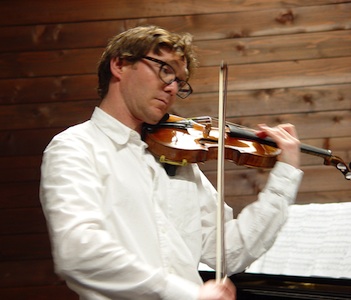
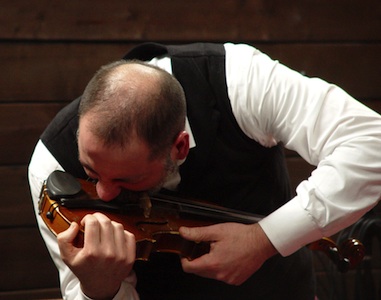 Photos by Michael Strickland Luciano Chessa and Benjamin Kreith Garrett - Confusing Salon Music and Noise since 2013 Local new music champions Luciano Chessa and Benjamin Kreith perform Garret - Confusing Salon Music and Noise since 2013 for violin, piano, bullhorn, saw, piano, Aardvark synth app, harmonica and voice. A concert-length program consisting of original pieces, Erik Satie transcriptions, Futurist noise poetry, Robert Schumann, a Fluxus piece, Carlo Prosperi's "Chant", delicate improvisations, Albeniz/Kreisler, and: Piedigrotta (1913): considered to be the pinnacle of Futurist sound poetry: Cangiullo's epic poem about the yearly Neapolitan street party dedicated to the Madonna di Piedigrotta. The explosions of firecrackers, the cries of street venders, the tenori battling at the annual song competition and, more in general, the sound of an entire city presented as a living organism, all reach a sudden jolt when the procession of the Black Madonna takes over the stage. By brilliantly hijacking onomatopoeic techniques typically found in Futurist poetry to mimic the explosions of mortars and shrapnels, and by forcing them to recreate the complexly articulated noise of a wild street party, Cangiullo truly succeeds here in celebrating-and synthesizing-life. Analfabeta (Illiterate, 1989/2013): Capo Caccia is a promontory punctuated by dramatic limestone cliffs. Under it, only a few miles from my hometown Sassari, caves run for miles by the Mediterranean coastline. As I utter the words "Capo Caccia," something specific resonates in the cavity. The exploration begins. With the marine sonar of the mind I locate a place at the heart of the deepest cave, and thus I name it: because it is a primordial, pre-cultural, pre-linguistic place. A retired Aleph-like situation where language is just as unnecessary as it is irrelevant. There, in my childish mind, I picture everything being unchanged since the Creation. Illiterate. I'm in search of the land of the water-filled men./Of arguing colors./Maybe you know/where it is located?/Capo Caccia, waterbeds, interconnected natural channels merges:/water, rocks, pools of warm water. Shells.../In between webs and ravines/there is a maze of pathways and subterranean springs,/labyrinthine caverns of stalactites,/limestone caves, meeting of waters./While freezing, guys, my urine turns blue./Poisonous giraffes, tropical fishes,/squirrels, spiders, scorpions and gnus,/cobalt blue monarch butterflies on their own wings,/river crickets, ocean cormorants,/what do you all know about all his problems?/Am I illiterate?/What "thing" means?/What "home" means?/You are illiterate./A rainy day, playing cards./Who was the first to utter "Z"?/Men filled with waters,/Laughing colors,/All the plane trees are in a good mood,/children and bunnies play bridge,/spheres smile while changing colors./A rainy day, playing Chess,/poisonous giraffes, tropical flowers/waves are breaking, reeds are rustling/a web of pathways and subterranean springs./Capo Caccia, groundwaters, interconnected natural channels merges:/water, rocks, pools of freshwater. Chessa/Kreith: Improvisation (2013) - for Vietnamese Dan Bau, Aardvark Synth App, Violin, Harmonica Erik Satie: Le Piège de Méduse (1913) - Transcribed for Violin and Piano by Chessa/Kreith (2012) Benjamin Kreith: O! Never Mind the Moon (2009) - for solo violin Robert Schumann: Intermezzo from the F-A-E Sonata (1853) Francesco Cangiullo: PP. G to N from Piedigrotta (1913) Luciano Chessa: Preludio e Siciliana (1987/2013) - for solo violin George Maciunas: Solo for Violin (for Sylvano Bussotti) (1962) - Score realized by Luciano Chessa Virgil Thomson: Alice Toklas, portrait No. 3 from Five Ladies (1930) Javier Arias Bal: Filipina para violín a la memoria de Felipa Martín (2009) Isaac Albeniz: Tango, No. 2 from the Suite España op. 165 (1890) - Transcribed by Fritz Kreisler (1927) Luciano Chessa: Analfabeta (1989) - Transcribed by Chessa/Kreith (2013) Luciano Chessa is active as a composer, performer, and “conductor”. His scores are published by RAI TRADE and Carrara and have been performed in Europe, U.S., and Australia. Recent compositions include “Squeeze! Squeeze! Squeeze!,” a large-scale work written for the quartertone vibe/quartertone electric guitar duo The Living Earth Show, and “A Heavenly Act,” an opera with video by Kalup Linzy commissioned by SFMOMA for the Ensemble Parallèle. Chessa is the author of “Luigi Russolo, Futurist” (University of California Press), the first English monograph dedicated to Russolo's Art of Noises. His Futurist expertise resulted in a commission by NYC's Biennial PERFORMA to direct the first reconstruction of Russolo's intonarumori orchestra and to curate/conduct concerts which received a 'Best of 2009' mention in The New York Times. In March 2011 Chessa conducted a sold-out intonarumori concert for Berliner Festspiele-Maerzmusik Festival; in December, for Art Basel | Miami Beach, he conducted the New World Symphony + Lee Ranaldo in the premiere of Ranaldo's “It All Begins Now!” Chessa teaches at the San Francisco Conservatory of Music, serves in the Advisory Board of TACET, the international research publication dedicated to Experimental Music from the Université Paris 1 - Panthéon-Sorbonne, is a member of the Steering Committee of the SF Electronic Music Festival, and collaborates with SF's Italian Cultural Institute. Violinist Benjamin Kreith has performed as a chamber musician, soloist and orchestra player throughout the US and Europe. He has premiered solo works at the Strasbourg and Marseille festivals and performed as a guest artist with the Ying and Muir Quartets. Ben helped to found the Ensemble CGAC in Santiago de Compostela, and has also performed with sfSound, Barcelona 216, and the Harvard Group for New Music. Recently he spent several years in Montana as a member of the Cascade Quartet and concertmaster of the Great Falls Symphony. He has had the privilege of working directly with composers including Francisco Guerrero, Gunther Schuller, and Magnus Lindberg. His live recording of Christian Lauba’s Kwintus for violin solo is available on the Accord/Universal CD Morphing. Ben also plays the harmonica and experienced a brief moment of renown when his improvisations with Leonard Bernstein were broadcast on international television. He has taught at the Escola de Música de Barcelona, and served as artist-in-residence at the University of California, Davis. |
|
|
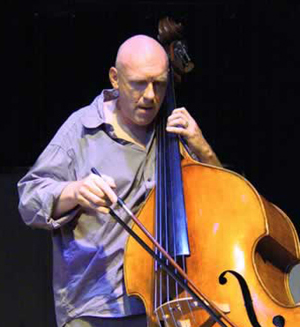

Grosse Abfahrt with Torsten Müller and Alfred Harth Two German expatriates (Alfred Harth and Torsten Müller) living now in allies of America, adding to Grosse Abfahrt — a freely-improvising music continuum/community whose name means “great departure” — another departure of meaning. From out this departure of de-parts comes a salute to epic failure, a disaster in full-dress uniform, gold epaulets dangling off the corpse of Western culture. In solidarity the local American cultural-exile cohort of Grosse Abfahrt joins in: Polly Moller - flute, bass flute Kyle Bruckmann - oboe, English horn Matt Ingalls - clarinet, bass clarinet, contrabass garden hose, violin Tom Djll - trumpets, bandleader John Shiurba - guitar Gino Robair - electronics, percussion Multi-instrumentalist (bass clarinet, alto saxophone, trumpet, and electronics), improviser, composer and visual artist Alfred Harth was born near Frankfurt in 1949. He first recorded at age twenty with the ensemble Just Music, with whom he recorded two LPs, one of which was issued on ECM. Throughout the 1970s he worked with musicians like pianist Nicole Van Den Plas, drummer Sven-Ake Johansson, bassist Peter Kowald, trumpeter Michael Sell and others in West European free music. In the late '70s, he became interested in punk music and in addition to a regularly-working duo with multi-instrumentalist Heiner Goebbels, he worked in punk / progrock / improvisation / modern composition combos like Cassiber and Gestalt et Jive. Since moving to Seoul, South Korea in 2001, he has been involved with Otomo Yoshihide's New Jazz Orchestra and his own multi-media projects. Torsten Müller (Born in Hamburg, Germany, 1957) is a free improvising bassist in Vancouver, Canada. He plays a 5-string double bass. He lived in Bremen and Hamburg from 1976 to 2001, where he started his musical career and worked as a radio host and producer at Radio Bremen, a public radio and television broadcaster. He came into the free improvised music scene in the mid 70s, first playing with Free Music Communion (an ensemble with guitarist Herbert Janssen and pianist Udo Bergner) recording three LPs on their own Fremuco Records label. He was a member of the large improvising ensemble King Ubu Orchestra for 10 years. He moved to Vancouver, Canada in 2001 where he has been performing at the Vancouver International Jazz Festival and acts as co-curator of the annual Time Flies Improvised Music Festival. He plays in various ensembles, including Vancouver based drummer Dylan Van Der Schyff's Bande X and his own ensemble, Hoxha, with British trombonist Paul Rutherford and Dylan Van Der Schyff. |
|
|


Michal Rataj and Andy Claussen's Wishbone Project From Prague, composer Michal Rataj presents a set of works for sound objects, writing desk, and live multi-channel electronics. Andy Claussen performs his Wishbone Suite, an extended work for improvising chamber ensemble of clarinet, accordion, trombone, piano and drums. The ensemble explores recurring folk-like themes as springboards into improvised material, creating "an alluring, whimsical, and just-plain-cool mix of jazz, classical, and experimental music. Challenging music that doesn’t shy away from being pretty" -eMusic. Clausen's ensemble features key members of Seattle's vibrant improvised music community; creators of The Racer Sessions, the Table & Chairs Label and The Improvised Music Project: Andy Claussen (trombone), Ivan Arteaga (clarinet), Aaron Otheim (accordion), Gus Carns (piano), and Chris Icasiano (drums). Michal Rataj (born 1975) is a composer, performer and sound designer based in Prague, Czech Republic. He composes mainly electroacoustic and chamber or orchestral instrumental music and receives performances throughout Europe and broadcasts worldwide. Recently he has been active as real-time performer of his acousmatic music and he gives sound performances alone or with different music partners. Rataj is assistant professor of electroacoustic music at the Academy of Performing Arts and at the NYU in Prague. He studied musicology (Charles University, Prague) and composition (Academy of Performing Arts, Prague) with prof. Ivan Kurz and prof. Milan Slavický. He also went to study in Egham (UK) and Berlin (D) and as a Fulbright Scholar he conducted research in Center For New Music And Audio Technologies at University of California, Berkeley, CA in the academic year 2007 - 2008. He has worked as a radio producer at the Czech Radio since 2003, where he has produced over 100 original radioart works with artists from around the world. He is a member of the EBU Ars Acustica Group, his music has been broadcast worldwide and performed throughout Europe and in the USA. Andy Claussen is a New York-based trombonist, composer and bandleader. An avid explorer of cross-genre territory, drawing inspiration from folk music, jazz, classical, and indie rock, Clausen has performed with new music mavericks Bill Frisell and Wayne Horvitz, pop sensation Feist and the avant-jazz saxophonist Andrew D’angelo. Hailing from Seattle, Clausen relocated to NYC in 2010 to begin his studies at the Juilliard School where he enjoys a diverse performance schedule, collaborating with choreographers, filmmakers, folk and blues artists, classical composers, as well as New York's jazz elite. An active bandleader since the age of 14, The New York Times has described his work as “sleek, dynamic large-group jazz, a whirl of dark-hued harmony and billowing rhythm…The intelligent sheen of Mr. Clausen’s writing was as striking as the composure of his peers…It was impressive, and not just by the yardstick of their age.” More info can be found at tableandchairsmusic.com. |
|
|
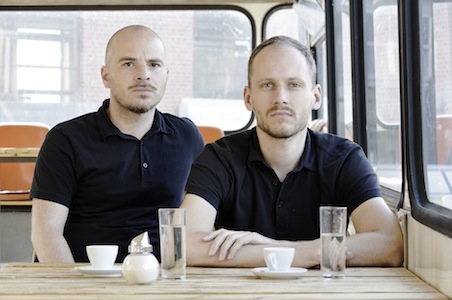

boris baltschun & serge baghdassarians bodybuilding Phill Niblock Disseminate Berlin-based artists boris baltschun & serge baghdassarians present bodybuilding, an hour-length theatrical piece for electronics, texts, electric fan, radio, table, hotplate, espresso maker, and fried chicken. bodybuilding retraces mathematician and astronomer Charles-Marie de La Condamine's journey to South America, though instead of the tropical wilderness, it measures the urban jungle of Rio de Janeiro. The three-sided Largo do Guimarães on the hills of Santa Teresa becomes the point of reference, where, its name, urban situation and sonic appearance are triangulated -- acoustically. On foot, and with an assortment of quasi-ritual exercises, the artists move from their residence in Rio to the triangular plaza. What stands at the end of their aural journey is the ideal form of a place, an artificial sounding-body that seems strangely familiar in the way it further alienates the alien. This performance celebrates the new release of bodybuilding for the publication on errant bodies. Opening the concert, sfSoundGroup performs Phill Niblock's Disseminate (1998) for 12 pre-recorded tracks and 4 live instrumentalists. Niblock's music creates sound differences by combining many simultaneous microtonal pitches / tones (by means of multitrack mixing) played on traditional instruments to make clouds of sum and difference tones. boris baltschun & serge baghdassarians have been collaborating since 1999 in the fields of sound installation and electronic music. Their work often focuses on the conception and realization of temporary as well as longtime installations that use mechanical means to realize an aesthetic inspired by electronic music. With references to outdated 19th century technology (lovers telegraph, steam engine f.e.) as well as computer controlled motor systems, a visualization of sonic phenomena is pursued. Of importance are also seemingly simple and minimal setups (well known, but appropriated materials), which produce complex results. Phill Niblock is a New York-based minimalist composer and multi-media musician and director of Experimental Intermedia, a foundation born in the flames of 1968's barricade-hopping. He has been a maverick presence on the fringes of the avant garde ever since. In the history books Niblock is the forgotten Minimalist. That's as maybe: no one ever said the history books were infallible anyway. His influence has had more impact on younger composers such as Susan Stenger, Lois V Vierk, David First, and Glenn Branca. He's even worked with Sonic Youth's Thurston Moore and Lee Renaldo on "Guitar two, for four" which is actually for five guitarists. This is Minimalism in the classic sense of the word, if that makes sense. Niblock constructs big 24-track digitally-processed monolithic microtonal drones. The result is sound without melody or rhythm. Movement is slow, geologically slow. Changes are almost imperceptible, and his music has a tendency of creeping up on you. The vocal pieces are like some of Ligeti's choral works, but a little more phased. And this isn't choral work. "A Y U (as yet untitled)" is sampled from just one voice, the baritone Thomas Buckner. The results are pitch shifted and processed intense drones, one live and one studio edited. Unlike Ligeti, this isn't just for voice or hurdy gurdy. Like Stockhausen's electronic pieces, Musique Concrete, or even Fripp and Eno's No Pussyfooting, the role of the producer/composer in "Hurdy Hurry" and "A Y U" is just as important as the role of the performer. He says: "What I am doing with my music is to produce something without rhythm or melody, by using many microtones that cause movements very, very slowly." The stills in the booklet are from slides taken in China, while Niblock was making films which are painstaking studies of manual labour, giving a poetic dignity to sheer gruelling slog of fishermen at work, rice-planters, log-splitters, water-hole dredgers and other back-breaking toilers. Since 1968 Phill has also put on over 1000 concerts in his loft space, including Ryoji Ikeda, Zbigniew Karkowski, Jim O'Rourke. |
|
|

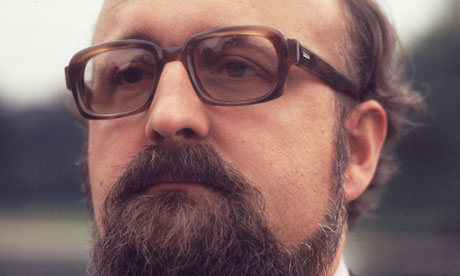
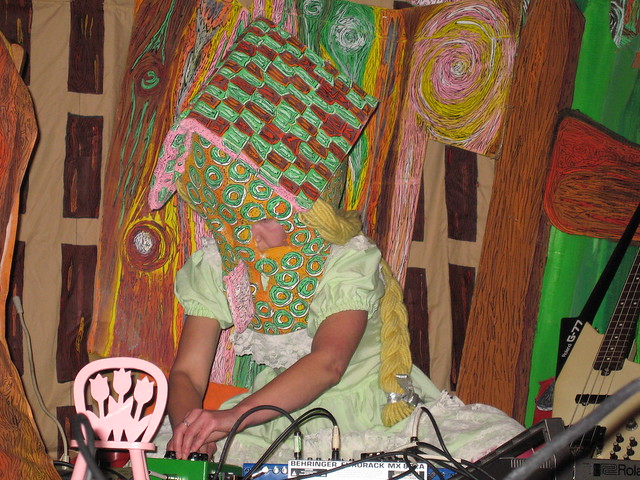
sharing a concert with the Sun Ra Arkestra and Hans Grusel's Krankenkabinet, sfSound performs Penderecki & Berio Krzysztof Penderecki Actions für Jazzensemble [1971] Penderecki's infamous work written for Don Cherry's The New Eternal Rhythm Orchestra, the piece combines "traditional" structured free-improv material with some of Penderecki's characterstic ensemble textures from that time. To the best of our knowledge, this is an American premiere!! Laborintus III : Omaggio a Berio Luciano Berio (1925-2003) was one of the extraordinary voices of the Darmstadt generation. Perhaps the most historically-minded member of that group, some of his greatest compositions are postmodern collages and recontextualizations of older works. For this special event, sfSound has revived our "Laborintus" project from 2004, in which we "Berio-ize" Berio through refashionings of his own works; the composer's interpretations of music history become the inspiration for transformations of his own compositions. With a Berio's Laborintus II forming the skeletal framework, we collage musical fragments and ideas taken from Berio's oeuvre, including: Laborintus II for voices, instruments, and tape [1965] Agnus for voices and clarinets [1971] Autre Fois for flute, clarinet, and harp [1971] Chamber Music for voice, clarinet, cello, and harp [1954] Chemins II for viola and ensemble [1972] Circles for voice, harp, and two percussionists [1960] Coro for voices and instruments [1976] Cries of London for voices [1973] Erdenklavier for solo piano [1969] Epifanie for voice and orchestra [1965] Folk Songs for chamber ensemble [1968] Gesti for solo recorder [1968] Momenti for tape [1960] O King for voice and five players [1968] Opus Number Zoo for woodwind quintet [1951] Passagio for voices and chamber orchestra [1962] Points on a curve to find... for piano and 23 instruments [1974] Re-call for chamber orchestra [1995] Rendering for orchestra [1990] Sequenza I for solo flute [1958] Sequenza III for solo voice [1966] Sequenza V for solo trombone [1965] Sequenza VII for solo oboe [1969] Sequenza VIIb for solo saxophone [1969] Sinfonia for eight voices and orchestra [1969] Still for orchestra [1973] Thema - Omaggio a Joyce for tape [1958] Violin Duos [1979-83] Visage for tape [1961] Selected Writings PERFORMERS Colin Thomson, voice Karen Thomson Hall, soprano Hadley McCarroll, soprano/keyboards Diane Grubbe, flute/voice Kyle Bruckmann, oboe/voice Matt Ingalls, clarinet/voice John Ingle, sax/voice Joshua Allen, sax Vijay Anderson, percussion/voice Ava Mendoza, e. guitar John Shiurba, e. bass guitar Tom Dambly, trumpet/voice Tom Djll, trumpet Theodore Padouvas, trumpet Brendan Lai-Tong, trombone/voice Benjamin Kreith, violin/voice Monica Scott, cello/voice Scott Walton, contrabass Tim Perkis, electronics/voice |
|
|
 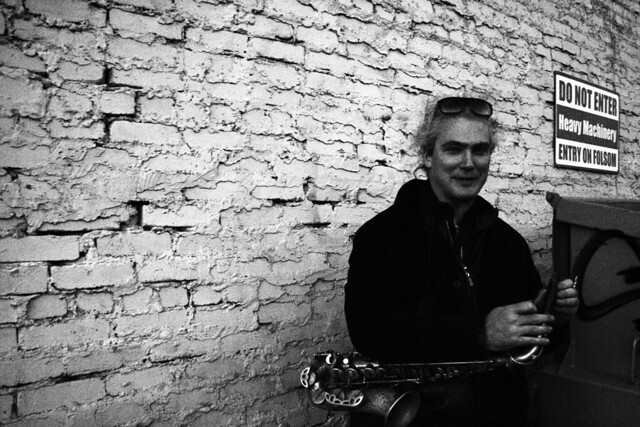 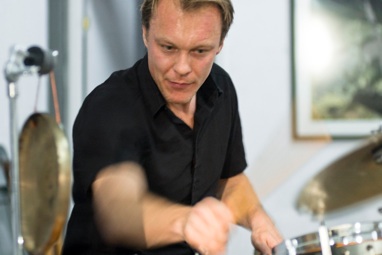
Goggle and John Ingle/Kjell Nordeson Goggle consists of four accomplished composer/performers who have worked for years together, inspiring and challenging one another deeply in terms of innovation of compositional structure and instrumentalism. The resulting music is unique, heartfelt, quirky and complex, drawing from a wide array of musical styles and ideas. Goggle Quartet will be performing throughout the summer in California and New Mexico. Goggle is the latest incarnation of a revolving group of players. The nucleus formed at Mills College in Oakland, California, in 1987 when graduate students Randy McKean and Dan Plonsey, inspired by a mutual love of the work of AACM stalwarts Anthony Braxton and Roscoe Mitchell, the World Saxophone and ROVA quartets, lured unsuspecting saxophonists into playing their original compositions, featuring quirky rhythmic schemes and extended techniques. Chris Jonas joined them in 1989, bringing a love of active, overlapping structure and melody. McKean and Jonas moved to NYC in 1992, but the group continued with Plonsey and Bostonian Steve Norton, performing and recording as the Great Circle Saxophone Quartet in the mid-1990’s. By the 00’s, Jonas’ former Oberlin schoolmate and instrumental hot-shot Cory Wright was pulled into the orbit as part of a touring saxophone sextet Plonsey formed to perform his music. Though subsequent relocations sent Jonas to Santa Fe and McKean, Plonsey and Wright to the San Francisco Bay Area, they have continued to collaborate and work together in various combinations, including the groups Daniel Popsicle and Bristle. sfSound members John Ingle and Kjell Nordeson open the concert with duo improvisations. Chris Jonas (soprano sax - Santa Fe, NM) works primarily as a composer, documentary filmmaker and video artist. He has written numerous commissions for new music ensembles, soundtracks, new circus, documentaries, and installations. Among Jonas’ recent commissions are multiple large-scale pieces for the Santa Fe Opera, “IN SITU” performances for SITE Santa Fe biennials, live soundtracks for silent films, large scale chamber works, and documentary soundtracks. Jonas is now at work on a number of new projects including a multiple year intermedia and music piece GARDEN with ensembles the San Francisco-based Del Sol String Quartet (Garden I "Night") and NYC's TILT Brass (Garden II "House") and a most recently a large scale commission, "The Gulf" with Philadelphia's new music choir, The Crossing. During his ten years in NYC, Jonas worked with many of today's most adventurous band leaders, including Butch Morris, Anthony Braxton, Cecil Taylor and William Parker. Jonas is a 2009 United States Artists award winner, a winner of the Meet the Composer/Commissioning USA award and a Rockwood Fellow. His is co-founder of the NM-based arts and social justice non profit, Littleglobe and President of the NYC Tri-Centric Foundation. Randy McKean (alto sax, clarinets - Bay Area, CA) leads or co-leads several bands, including the chamber jazz quartet Bristle (w/Cory Wright, Lisa Mezzacappa & Murray Campbell), the improv trio Pluck Vim Vigour (w/Ross Hammond), avant-folk duo Sawbones (w/Maxima Kahn), and the acoustic-electronics duos Wild Horsey Ride (w/Wes Steed), Zap! (w/David Dvorin) and The Gargantius Effect (w/Campbell). He has composed works for string quartet and symphony orchestra. McKean’s releases include the CDs Wild Horsey Ride, Bristle’s Bulletproof (Edgetone), So Dig This Big Crux (Rastascan), the Great Circle Saxophone Quartet’s Child King Dictator Fool (New World), and the electronic release Gargantius Effect +1+2+3 (w/Han-earl Park, Gino Robair & Scott Looney). He studied with trumpeter Paul Smoker and composers Anthony Braxton, David Rosenboom, and Maggi Payne. He currently lives in the Sierra Nevada foothills town of Grass Valley, CA. Dan Plonsey (tenor sax, clarinets - Bay Area, CA) is a composer, saxophonist, and math teacher. He has written a surprisingly large number of pieces, mostly for his own ensembles, of which Daniel Popsicle (a group of 15) and New Monsters/Monstrosities (Quintet) are currently active. He has received several commissions, most recently “Leave Me Alone!” an opera with libretto by Harvey Pekar, which was performed at Oberlin in 2009; “Dan Plonsey's Bar Mitzvah,” a collaboration with Mantra Plonsey and Eric Kupers was performed the following year, commissioned by the Jewish Music Festival; and "Student Work": 27 songs with texts about Geometry written by students, in performance this summer. In 2010, Plonsey was awarded a United States Artists fellowship. His most recent CD, Football Season, an eight-quarter composition for small brass band, just came out in April, 2013. Cory Wright (baritone sax, winds - Bay Area, CA) has been involved in both the jazz and creative music worlds for the past 20 years, including time spent in New York, Los Angeles and his current home in the San Francisco bay area. His recent projects [the Green Mitchell Trio and the Cory Wright Outfit] reflect his interest in blurring the distinction between composed and improvised material and in combining the harmonious with the atonal, and groove with the arrhythmic. Cory has played in ensembles lead by Anthony Braxton, Vinny Golia, Eddie Gale, Adam Rudolph and Yusef Lateef. He is currently a member of bay area groups Bristle, Wiener Kids, Daniel Popsicle, and the Oakland Active Orchestra. Saxophonist/composer/improviser John Ingle is originally from Memphis, TN and now resides and works in San Francisco. His music is informed and influenced by contemporary concert music, improvised music, electronic music, jazz, various Asian folk music traditions, and the blues and gospel of his native Southeast US. He collaborates with electronics innovator Laetitia Sonami, and in duo with NYC-based composer/dulcimerist Dan Joseph and is a founding member of the sfSoundGroup. John's solo saxophone music emphasizes multiphonics, vocal harmonics and subtle control of extended saxophone techniques, while his chamber music explores such musical parameters as spiral time, linear pulse, and non-linear harmony, and indulges in both simple resonance as well as complex timbre and auditory sleights-of-hand. Kjell Nordeson, percussionist, divides his time between Stockholm and San Francisco. He has a BA from Stockholm University, and has studied classical percussion at Ingesund School of Music with Bjˆrn Liljeqvist, former principal percussionist of the Stockholm Philharmonic. Together with saxophonist Mats Gustafsson, he formed AALY Trio in 1986. AALY Trio became one of the leading groups in the Swedish experimental scene in the 90ís. Nordeson has toured extensively in North America, Europe, North Africa and Japan with various groups. He has performed with Peter Brˆtzmann, Barry Guy, Ken Vandermark, Joe Morris, William Parker, Paul Rutherford, Gerry Hemingway, Frank Gratkowski, Stefano Scodanibbio, and many others. Since 2004, Nordeson has been active in the San Francisco Bay Areaís thriving community of free-improvised, experimental and new music. He regularly plays with musicians Larry Ochs, Jon Raskin, Greg Goodman, George Cremaschi, Scott Looney, Damon Smith, John Ingle, sfSoundGroup, Aram Shelton, Darren Johnston, Lisa Mezzacappa and many others. |
|
|
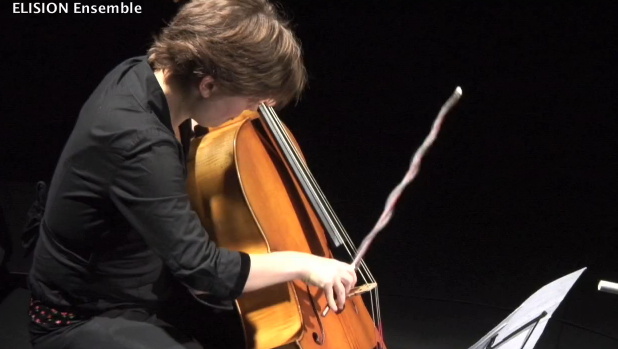
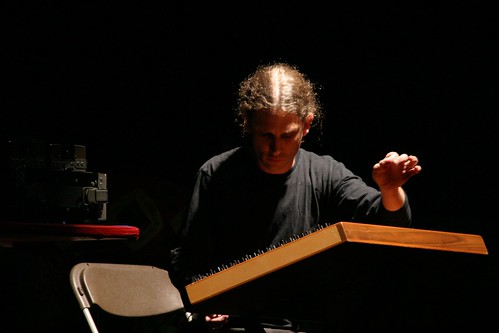
$Ɛ∨ƐR!ℵƐ ℬa||0∩ and Dan Joseph & Andrea Williams French cello virtuoso $Ɛ∨ƐR!ℵƐ ℬa||0∩ presents solo works in her first visit to the West Coast as part of a collaboration with the Poto Festival. The program includes music by Australian composer and Stanford graduate Kristian Ireland; Bernd Alois Zimmermann's great Sonata from 1960; and the American premiere of Erik Ulman's L'Extase de M. Poher, after the poem by Jeremy Prynne. Collaborators since 2011, Brooklyn-based composer Dan Joseph and Oakland-based sound artist Andrea Williams will perform a collaborative electroacoustic soundscape with hammer dulcimer, field recordings, soundmakers and electronics. $Ɛ∨ƐR!ℵƐ ℬa||0∩ studied cello at the Hochschulen für Musik in Berlin and Lübeck with Joseph Schwab and Troels Svane. In 2004-2005 she was a participant in the International Ensemble Modern Academy. She has also undertaken further studies in contemporary cello technique with Siegfried Palm, Lukas Fels and Rohan de Saram. In 2006-2007, she was a solo cellist in the Toulouse Chamber Orchestra, before deciding to specialise in contemporary music performance. Séverine is a member of the ensembles ELISION (Australia), Ensemble Sillages and multilatérale (Paris) and works regularly with such ensembles as Klangforum Wien, musikFabrik (Cologne), Ictus, Ensemble Inytercontemporain… In 2008-2009 she was at Akademie Schloss Solitude (Stuttgart) for a six-month residency. She attaches particular importance to working directly with composers (Helmut Lachenmann, Liza Lim, James Dillon, Jonathan Harvey…) and has premiered several solo works (Liza Lim, Erik Ulman, Stefano Bulfon, Alex Sigman…). She has recently collaborated with composer David Coll on his multimedia work 68 at IRCAM, and on an installation project with photographer Evi Keller. She regularly performs in a duo with electronic artist Sébastien Roux. $Ɛ∨ƐR!ℵƐ ℬa||0∩ has been a prize-winner of the 2004 international contemporary music performance competition Gioia del Colle (Italy) and of the Marie-Luise Imbusch Foundation. Dan Joseph is a composer based in New York City. He began his career as a drummer in the vibrant punk scene of his native Washington, DC and was later active in the experimental tape music underground, producing works for independent labels in the U.S. and abroad. Moving to California in the early ‘90s, he completed his academic work at CalArts and Mills College, where his principal teachers included Pauline Oliveros, Alvin Curran, Mel Powell and Terry Riley. Since the late 90s, the hammer dulcimer has been the primary vehicle for his music and he is active as a performer with his own chamber ensemble, The Dan Joseph Ensemble, as well as in various improvisational collaborations and as a soloist. He also the curator of Musical Ecologies, a monthly symposium on music and sound in Park Slope, Brooklyn. Andrea Williams is a sound artist and composer currently living in Oakland, CA. She utilizes site-specific elements and perceptual cues to reveal the unseen connections between people and their environment. Her compositions make use of field recordings, instruments, computer technologies and the sound of the performance space itself. She has led soundwalks in New York and the Bay Area, and has shown and performed both solo and with various musicians at galleries and alternative spaces internationally, such as the Whitney Museum, Headlands Center for the Arts, Children’s Creativity Museum, NPR, Miami Art Fair, and the Mamori sound artist residency in the Amazon rainforest. Andrea is a founding member of the New York Society for Acoustic Ecology and is the Co-Director of the sound art non-profit, 23five, in San Francisco. 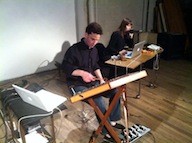 Dan Joseph & Andrea Williams on YouTube Dan Joseph & Andrea Williams on YouTube
|
|
|

Seth Cluett & sfSoundGroup Visiting from New Jersey, Seth Cluett presents a live set using sung and electronically generated sine tones, room acoustic phenomena, and recorded sound exploring the boundary between personal and communal listening. Constructing a focused, attentive perceptual space and an elastic, malleable experience of duration, the sound world of this work is tensely suspended between full body immersion and brittle, sparse timelessness. sfSoundGroup performs a program with instruments and electronics: Johanna Beyer - Music of Spheres (1938) for electronics and percussion James Tenney - Ergodos II (for John Cage) (1978) for computer generated tape with any number of strings, winds, brass, voices, and percussion Paul Dresher - Channels Passing (1982) for oboe, clar, saxophone, trumpet, trombone, violin, and cello sfSoundGroup - Improvisation (2013) Seth Cluett (b. Troy, NY) is an artist, performer, and composer whose work ranges from photography and drawing to video, installation, concert music, and critical writing. His “subtle…seductive, immersive” (Artforum) sound work has been characterized as “rigorously focused and full of detail” (e/i) and “dramatic, powerful, and at one with nature” (The Wire). Boomcat described his 2011 CD Objects of Memory on the Line Imprint as a “beautifully tremulous and thoughtful exploration in electro-acoustic sound.” His work explores everyday actions at extreme magnification, celebrates minutae by amplifying impossible tasks, and explores the workings of memory in forms that rethink the role of the senses in an increasingly technologized society. The recipient of grants from Meet the Composer, The Foundation for Contemporary Arts Emergency Grant Program, and the Andrew W. Mellon Foundation, he has presented work internationally at venues such as the MATA Festival, MassMoCA, The Kitchen, GRM, Palais de Tokyo, FRAC Franche-Compté, STEIM, and Dundee Contemporary Arts. Recent work is documented on the Line Imprint, Radical Matters, Sedimental, and Winds Measure recordings. This past fall Cluett joined the faculty of Contemporary Arts at Ramapo College of New Jersey where he teaches courses in audio engineering as well as electronic and experimental sound practices. sfSoundGroup Monica Scott, cello Brendan Lai-Tong, trombone Benjamin Kreith, violin John Ingle, saxophone Matt Ingalls, clarinet Tom Dambly, trumpet Kyle Bruckmann, oboe |
|
|
|
|
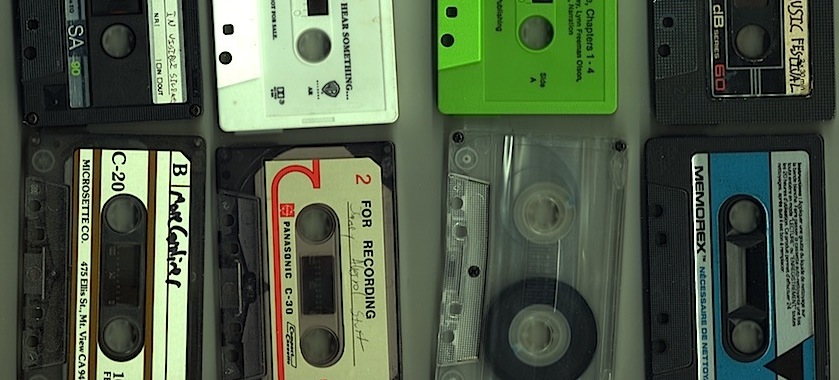
A Live Diffusion Concert by the SFTMC Since 2002, the San Francisco Tape Music Collective (a project of sfSound) has presented its annual 3-day festival of fixed media (aka "tape") compositions diffused live over a multi-speaker array. The festival usually takes place in January, but some of us just can't wait that long! The collective presents a single evening of tape music projected over a surround-sound system especially tailored to the Center for New Music's unique architecture. The program includes some of the "greatest hits" from past festivals, including recent acoustic compositions by international composers; works by SFTMC members Kent Jolly, Matt Ingalls, Cliff Caruthers, and Thom Blum; and a live diffusion of Edgard Varèse's Poème Électronique (1958). |
|
|
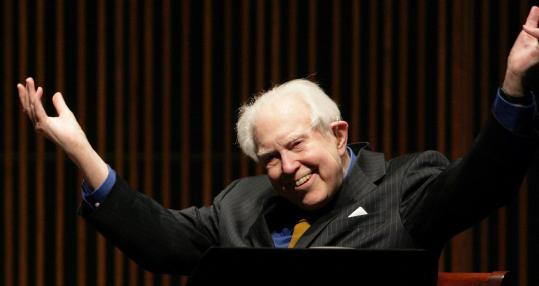
An evening of music by Elliott Carter sfSoundGroup performs a program dedicated to the memory of Elliott Carter (1908-2012), with selections of solo and chamber works spanning his entire career. PROGRAM Cello Sonata (1948) for cello and piano Canon for Three Equal Instruments (1971) "In Memoriam Igor Stravinsky" Riconoscenza per Goffredo Petrassi (1984) for violin Inner Song (1992) for oboe Tempo e Tempi (1998) for soprano, violin, cello, English horn, bass clarinet an improvisation/deconstruction of Hiyoku (2001) for two clarinets Steep Steps (2001) for bass clarinet Figment II (2001) for cello Caténaires (2006) for piano Intermittences (2007) for piano Retracing III (2009) for trumpet Rigmarole (2011) for cello and bass clarinet MUSICIANS Monica Scott, cello Hadley McCarroll, piano Benjamin Kreith, violin John Ingle, saxophone Matt Ingalls, clarinet Julia Hathaway, soprano Tom Dambly, trumpet Kyle Bruckmann, oboe |
|
|

An evening of music by Elliott Carter sfSoundGroup performs a program dedicated to the memory of Elliott Carter (1908-2012). This past November, Elliott Carter passed away at the age of 103. Carter was one of the most influential American voices in classical music and a leading figure of modernism in the 20th and 21st centuries. The program presented here covers the entire range of Carter's surprisingly musically diverse and prolific career -- starting with the work where Carter "invented" metric modulation and ending with a recent composition written for his 103rd birthday concert. Featuring a couple of bay area premieres, virtuosic performances, and a special improvisational performance based on Carter's work (his music always sounded strikingly similar to jazz and improv to us!), this concert puts a unique West Coast take on the many recent and upcoming tribute concerts. Do not miss it!. PROGRAM Cello Sonata (1948) for cello and piano Canon for 3 (1971) "In Memoriam Igor Stravinsky" Riconoscenza per Goffredo Petrassi (1984) for violin Inner Song (1992) for oboe Tempo e Tempi (1998) for soprano, violin, cello, English horn, bass clarinet an improvisation/deconstruction of Hiyoku (2001) for two clarinets Steep Steps (2001) for bass clarinet Caténaires (2006) for piano Intermittences (2007) for piano Rigmarole (2011) for cello and bass clarinet MUSICIANS Monica Scott, cello Hadley McCarroll, piano Benjamin Kreith, violin John Ingle, saxophone/conductor Matt Ingalls, clarinet/bass clarinet Julia Hathaway, soprano Tom Dambly, trumpet Kyle Bruckmann, oboe/english horn |
|
|
|
|

Hadley McCarroll/Janis Mercer & Kyle Bruckmann/James Fei like-minded and like-"instrumented" local performer-composer Kyle Bruckmann and James Fei two dedicated practitioners of eccentric distended reed technique entwine single lines, repurposing overlapping electronic musical tendencies, into a thicket of psychoacoustic intrigue. Hadley McCarroll and Janis Mercer The pianists celebrate 100 years of Stravinsky's "Rite of Spring" while exploring connections in various provocative and moving solo piano music from the last century: PROGRAM Anthony Braxton Composition #5 Luciano Berio wasserklavier & erdenklavier Peter Eötvos Erdenklavier - Himmelklavier Sever Tipei Lament Claude Debussy Preludes, Book II "Brouillards" Igor Stravinsky Rite of Spring, Part I for one piano/four-hands Each piece on the concert reveals how these remarkable composers question preexisting styles and mores of the day, discarded previous techniques, and forged a new path, led by Igor Stravinsky. Pianist Hadley McCarroll has been hailed for her “...lively and exhilarating...” pianism (San Francisco Classical Voice). A well-known collaborative and solo pianist who performs not only throughout the San Francisco Bay Area, but throughout the United States and internationally with the Royal Danish Opera, San Francisco Opera, San Diego Opera, Utah Festival Opera, American Conservatory Theater, and the Chicago Lyric Opera Center for American Artists. She is currently working with Alonzo King's LINES Ballet; she will travel with the company to Paris, Chicago and New York this year to perform King's new work "Constellation". Hadley has also appeared on the Festival del Sole in Napa Valley. Equally at home as a soloist, her recitals feature thoughtful repertoire that centers around the human condition. Recent highlights of the past season include performances of "Sonatas and Interludes" by John Cage at the San Francisco Museum of Modern Art; she also performed recitals of Beethoven, Ligeti, Liszt and Schumann at Old First Concerts. Hadley is the founding pianist of the Mirage Ensemble, a soprano-clarinet-piano trio now in its 18th season. Since 2006 she has performed with cellist Monica Scott as the duo martha & monica; they recorded an album at Skywalker Ranch, and have received multiple grants and honors. Janis Mercer is an American pianist/composer living in San Francisco. She has performed solo piano concerts of new music throughout the United States. Her performance of Paul Rudy's Church Keys appears on the New Music Circle's Season Highlights Volume I: 2002-04 CD. Her recording of Brian Belét's Four Proportional Preludes appears on SCI's Chamber Works CD, available on Capstone Records. Her most recent chamber piece, Beloveds, is featured on einklang records. Her percussion solo, Air is published by Media Press. Daniel Adams featured the composition in his paper on drum set works, published in the American National Association of College Wind and Percussion Instructors Journal, Spring, 2004 No. 3 and Kevin A. Nichols features the work in his dissertation on percussion music. She performed Anthony Braxton's solo piano music in California, Illinois, and New York through lectures at colleges and in public concerts. She has a strong interest in the music of the Second Viennese School but also performs living composers and has commissioned solo works. Her compositions have been for single instrument, chamber music and/or voice, and use serial techniques and structured improvisation, but now she is composing more electro-acoustic works. Some of her compositions feature social issues and leftist political views in their structuring. Oakland, CA-based oboist and composer/performer Kyle Bruckmann's work extends from a Western classical foundation into genre-bending gray areas encompassing free jazz, electronic music and post-punk rock. He is a member of acclaimed new music collective sfSound, the San Francisco Contemporary Music Players, Eco Ensemble, and Quinteto Latino. He has worked with the San Francisco Symphony and most of the area¹s regional orchestras, while becoming firmly enmeshed in the vibrant local improvised music community. From 1996 until his westward relocation, he was a fixture in Chicago's experimental music underground; long-term affiliations include the electro-acoustic duo EKG, the art-punk monstrosity Lozenge, and the Creative Music quintet Wrack. James Fei (b. Taipei, Taiwan) moved to the US in 1992 to study electrical engineering. He has since been active as a composer and performer on saxophones and live electronics. Works by Fei have been performed by the Bang on a Can All-Stars, Orchestra of the S.E.M. Ensemble, MATA Micro Orchestra and Noord-Hollands Philharmonisch Orkest. Recordings can be found on Leo Records, Improvised Music from Japan, CRI, Krabbesholm and Organized Sound. Compositions for Fei's own ensemble of four alto saxophones focus on physical processes of saliva, fatigue, reeds crippled by cuts and the threshold of audible sound production, while his sound installations and performance on live electronics often focus on feedback. Since 2006 Fei has taught at Mills College in Oakland, where he is Associate Professor of Electronic Arts. |
|
|

Quinteto Latino Latin American Chamber Music Festival Part of Quinteto Latino's first ever festival of Latin American Chamber Music, a concert featuring QL flutist Diane Grubbe, sfSound cellist Monica Scott, QL & sfSound oboist Kyle Bruckmann, Latin American composers/performers Patricia Martínez, Guillermo Galindo and Bruno Ruviaro, and other guests. Bruno Ruviaro's "Panela de Pressão" is an improvisation piece created with Juan-Pablo Caceres. The duo has been working together since 2005, with long stretches of silence between each new piece. "Visual Poetry" is an intermedia work combining electronic music and projected images. Each short "poem" presents sonic and visual ideas surrounding basic sounds typical of Brazilian Portuguese. PROGRAM Patricia Martínez (Argentina, b. 1973) los tiempos del alma (2009) for flute and cello Guillermo Galindo (Mexico, b. 1960) excerpts from Voces del Desierto/Voices of the Desert (2012) for flute, oboe, and original found-object instruments Bruno Ruviaro (Brazil, b. 1976) & Juan-Pablo Caceres (Chile) Panela de Pressão (2013) for live electronics Bruno Ruviaro (Brazil, b. 1976) & Carr Wilkerson (USA) Visual Poetry (2013) for live electronic sound and visuals please join us for a recpetion following! PERFORMERS & COMPOSERS Flutist Diane Grubbe freelances in the San Francisco Bay Area and has performed with Pocket Opera, Napa Valley Symphony, Golden Gate Opera, Lamplighters, Lyric Opera, Festival Opera and others. Contemporary music performances include numerous appearances with sfSound as well as performances with Earplay and the Eco Ensemble. As a member of Quinteto Latino, she has performed numerous seasons in the San Francisco Symphony’s “Adventures in Music” program. Quinteto Latino recently completed a CD of Mexican music from the last 100 years featuring works of Carlos Chávez, Mario Lavista, Arturo Márquez, José Luis Hurtado and others. Monica Scott has performed throughout the United States, in almost every European country, Argentina, Canada and South Korea, engaging audiences with her energetic, eloquent playing. After an artist residency at the Banff Centre (Canada) in 1994, Monica performed for four seasons with the Orquestra Metropolitana de Lisboa in Portugal, with whom she also appeared as concerto soloist. Since moving to the Bay Area in 1998, Monica has been actively promoting new music, as a member of the composer/improviser collective sfSoundGroup, and performing with Composers’ Inc., the Composers Alliance, and in numerous chamber music groups; she was the cellist of the award-winning San Francisco-based Del Sol String Quartet from 2001-2005. Monica is also a devoted teacher, serving on the faculties of the San Francisco Conservatory of Music Preparatory Department, The Crowden School, in Berkeley, and College Preparatory School, in Oakland, and maintains an active private studio. She holds degrees from the Oberlin Conservatory of Music and the Sweelinck Conservatorium Amsterdam. Patricia Martínez is a composer, improviser, pianist, and multi-disciplinary artist. She holds Masters and DMA degrees in composition from Stanford University where her advisor was Brian Ferneyhough. She also completed the Annual Course at the IRCAM. She has been a director and performer in different experimental ensembles. Her works have received international awards including 1st prize Buenos Aires City Government; 1st prize at "The International Young Composers’ Meeting" (Holland) and 1st prize National Competition J. C. Paz. Oakland, CA-based oboist and composer/performer Kyle Bruckmann's work extends from a Western classical foundation into genre-bending gray areas encompassing free jazz, electronic music and post-punk rock. He is a member of acclaimed new music collective sfSound, the San Francisco Contemporary Music Players, Eco Ensemble, and Quinteto Latino. He has worked with the San Francisco Symphony and most of the area¹s regional orchestras, while becoming firmly enmeshed in the vibrant local improvised music community. From 1996 until his westward relocation, he was a fixture in Chicago's experimental music underground; long-term affiliations include the electro-acoustic duo EKG, the art-punk monstrosity Lozenge, and the Creative Music quintet Wrack. Guillermo Galindo's composition work blurs the conventional limits that define music and the art of music composition itself. Galindo’s wide approach to concepts such as musical form, time perception, music notation, sonic archetypes and instrumentation span through a wide spectrum of artistic works performed and shown at major festivals, concert halls and art exhibits throughout the United States, Latin America, Europe, and Asia. From symphonic and chamber composition to live performance art and comprising the domains of musical and visual computer interaction, electroacoustic music, opera, film, instrument building, three dimensional installation, improvisation and sound design Galindo’s work has always remained in constant flux. His orchestral composition includes two symphonies Ome Acatl premiered in Mexico City by the OFUNAM orchestra (1997) and Trade Routes (2006) commissioned and premiered by the Oakland East Bay Symphony Orchestra and chorus. His operas include two major works: Califas 2000 with text and performance by MacArthur Fellow Guillermo Gomez Peña and Decreation/Fight Cherries with text by MacArthur Fellow poet Anne Carson. Bruno Ruviaro, composer and pianist from São Paulo, Brazil, was born in 1976, and has lived in 22 different places: Rua Theodureto Souto, Rua Cajati, Casa do Seu Demétrio, Rua São Borja, Rua James Adam, Alameda dos Uirapurus, Avenida Modesto Fernandes, Avenida Santa Izabel, Rua Nuno Álvares Pereira, Rua Prof. Djalma Bento, Rua Dr. Nestor Esteves Natividade, Rua Major Diogo, North Park Street, Jericho Street, Olmsted Road, Thoburn Court, Comstock Circle, Via Parma, Rue de l’Hôtel de Ville, Greenoaks Drive, Miramar Street, 26th Street. Juan-Pablo Caceres is a composer, performer and engineer born in Santiago, Chile. He is currently a PhD student in computer music at CCRMA, Stanford University (USA). His work includes instrumental and electronic pieces, as well as performance of avant-garde rock music, with a albums edited in Europe and America. Juan-Pablo's interests include Internet music and performance, virtual acoustic spaces, popular experimental music, boundary pushing computer music (in both directions). Carr Wilkerson is a System Administrator at CCRMA specializing in Linux and Mac OS systems. He is a controller and software system builder and sometime performer/impresario, instructor and researcher. He has a BS in Physics from Tulane University, Master of Arts in Music Science and Technology from Stanford (CCRMA), a Master of Engineering in Electrical Engineering from Tulane, and refers to himself in the third person. In a previous life, he was a US Navy Nuclear Propulsion Engineer (think Scotty). |
|
|

SFMUSIC DAY sfSound's affiliate host, The San Francisco Friends of Chamber Music presents its highly-popular annual free SFMUSIC DAY! Fitting within the "Latin American Connections" theme his year, sfSound presents a program of contemporary music and graphic scores by Guillermo Gregorio, Patricia Martínez, and Monica Scott. PERFORMERS Monica Scott, cello Benjamin Kreith, violin John Ingle, saxophone Matt Ingalls, clarinet Diane Grubbe, flute Kyle Bruckmann, oboe |
|
|
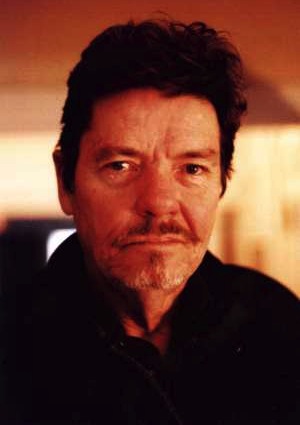   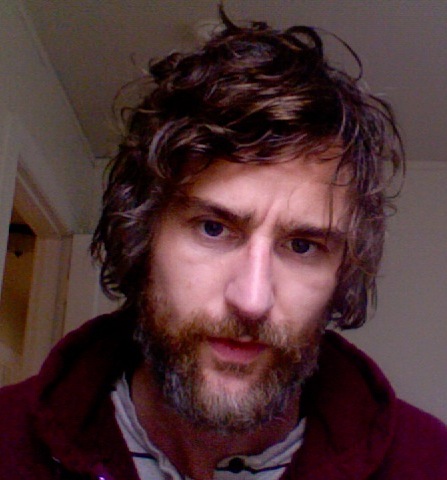
An evening of closely-tuned frequencies An evening of music featuring closely-tuned frequencies by Alvin Lucier, James Tenney, Phill Niblock, and John Krausbauer. If any "theme" has been established with this year's sfSoundSalonSeries, it is contemporary music featuring simultaneous frequencies that are tuned (or de-tuned) close enough to create timbral effects like beating, phasing, and difference tones. This concert presents an entire evening of such sounds, with sfSound's Matt Ingalls performing Alvin Lucier's In Memoriam John Higgins for clarinet and sweeping sine tone, Benjamin Kreith performing James Tenney's classic "postal piece", Koan for solo violin, and sfSound reprising its realization of Phill Niblock's Disseminate for multi-tracked acoustic instruments. Los Angeles-based John Krausbauer (with Vicky Fong and Blaine Todd) performs his recent composition, phased-glissando, a long-duration composition for a slowly and manually tuned, and manually phased glissando, played against a fundamental (drone) frequency. [A (110hz): fundamental/drone A (110 hz) - D (146.83 hz): glissando]. The sound textures generate a multitude of beating tones, audibly active harmonic movement, and complex overtone patterns, as well as other psychoacoustic phenomena. Composer/improvisor John Krausbauer lives and makes music in Los Angeles. Recent endeavours include solo music for violin/voice/synth, the microtonal amplified-acoustic group/s - aures; and, the ecstatic music band; the country-boogie-blues-raga-new music duo, jpjjk, (w/jp jenkins); and the long running guitar power-drone group, tecumseh. he has been performing his music for the last 16 years, playing in various contexts and in a multitude of performance spaces/settings/situations and has released his music on numerous independent labels. Alvin Lucier was born in 1931 in Nashua, New Hampshire. He was educated in Nashua public and parochial schools, the Portsmouth Abbey School, Yale, and Brandeis and spent two years in Rome on a Fulbright Scholarship. From 1962 to 1970 he taught at Brandeis, where he conducted the Brandeis University Chamber Chorus which devoted much of its time to the performance of new music. Since 1970 he has taught at Wesleyan University where he is John Spencer Camp Professor of Music. Lucier has pioneered in many areas of music composition and performance, including the notation of performers' physical gestures, the use of brain waves in live performance, the generation of visual imagery by sound in vibrating media, and the evocation of room acoustics for musical purposes. His recent works include a series of sound installations and works for solo instruments, chamber ensembles, and orchestra in which, by means of close tunings with pure tones, sound waves are caused to spin through space. Phill Niblock is a New York-based minimalist composer and multi-media musician and director of Experimental Intermedia, a foundation born in the flames of 1968's barricade-hopping. He has been a maverick presence on the fringes of the avant garde ever since. In the history books Niblock is the forgotten Minimalist. That's as maybe: no one ever said the history books were infallible anyway. His influence has had more impact on younger composers such as Susan Stenger, Lois V Vierk, David First, and Glenn Branca. He's even worked with Sonic Youth's Thurston Moore and Lee Renaldo on "Guitar two, for four" which is actually for five guitarists. This is Minimalism in the classic sense of the word, if that makes sense. Niblock constructs big 24-track digitally-processed monolithic microtonal drones. The result is sound without melody or rhythm. Movement is slow, geologically slow. Changes are almost imperceptible, and his music has a tendency of creeping up on you. The vocal pieces are like some of Ligeti's choral works, but a little more phased. And this isn't choral work. "A Y U (as yet untitled)" is sampled from just one voice, the baritone Thomas Buckner. The results are pitch shifted and processed intense drones, one live and one studio edited. Unlike Ligeti, this isn't just for voice or hurdy gurdy. Like Stockhausen's electronic pieces, Musique Concrete, or even Fripp and Eno's No Pussyfooting, the role of the producer/composer in "Hurdy Hurry" and "A Y U" is just as important as the role of the performer. He says: "What I am doing with my music is to produce something without rhythm or melody, by using many microtones that cause movements very, very slowly." The stills in the booklet are from slides taken in China, while Niblock was making films which are painstaking studies of manual labour, giving a poetic dignity to sheer gruelling slog of fishermen at work, rice-planters, log-splitters, water-hole dredgers and other back-breaking toilers. Since 1968 Phill has also put on over 1000 concerts in his loft space, including Ryoji Ikeda, Zbigniew Karkowski, Jim O'Rourke. James Tenney has been a highly influential figure in American music, particularly in promoting various strands of twentieth century avant-garde, from Ives forward. He has also been a prolific composer, writing extensively for various unusual instrumental combinations (some involving electric guitar, gamelan, percussion, or tape delay), and he was a leading figure in the electro-acoustic movement of the 1960s, also creating some important early computer compositions. Tenney's interest in computers, acoustics, psychoacoustics, and music cognition is not surprising considering he studied engineering at the University of Denver from 1952 to 1954. Only after that did he devote himself full-time to music, studying piano with Eduard Steuermann at Juilliard and composition with Lionel Nowak at Bennington College and the University of Illinois; mentors there were Kenneth Gaburo in composition and Lejaren Hiller in information theory and electronic music. Tenney also worked for a while with such maverick figures as Harry Partch, Carl Ruggles, and Edgard Varèse. The 1960s found Tenney conducting research at the Bell Laboratories (1961-1964), Yale (1964-1966), and the Brooklyn Polytechnic Institute (1966-1970), where he deeply explored the early possibilities of electronic music. Later years saw him teaching at the California Institute of the Arts, the University of California at Santa Cruz, and Toronto's York University. Tenney co-founded and directed the Tone Roads Ensemble, which from 1963 to 1970 was a significant force in the Ives revival. He also performed with the ensembles of early minimalists Steve Reich and Philip Glass while fostering relationships with such figures as Stan Brakhage, John Cage, Morton Feldman, and Max Neuhaus. Tenney was also an influential theorist with an approach to form stems from his understanding of the phenomenological bases of music perception. He has also investigated "harmonic space," his term for experimental intonation. |
|
|
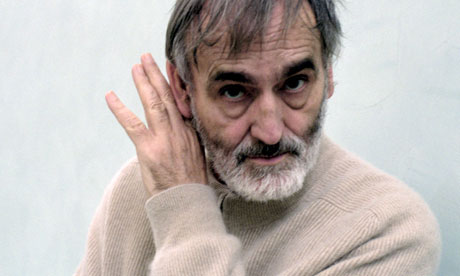 
Helmut Lachenmann's Dal Niente & Andrew Raffo Dewar's Ekphrasis Suite Andrew Raffo Dewar presents the premiere of his "Ekphrasis Suite," a set of compositions developed as sonic translations of the austere drawings of visual artist Pete Schulte. Dewar will perform with his "Interactions Quartet," featuring the composer on soprano saxophone, Gino Robair (vibraphone, percussion), Kyle Bruckmann (oboe, english horn), and John Shiurba (acoustic and electric guitars). sfSound clarinetist Matt Ingalls opens the concert with a performance of Helmut Lachenmann's Dal Niente (Interieur III) (1970). Like other Lachenmann compositions from this period, Dal niente is indebted from a technical perspective to the idea of a “musique concrète instrumentale”, in which all of the sounds point away from themselves to a certain extent toward the preconditions of their production, bringing the latter into the structural events as a kind of “corporal” experience. The “instrument” becomes a “device”: a characteristically manipulated filter for the player’s breath as controlled by the composition and its interpretation. The independent modification in finger positions, types of attack, and the forms of articulation in air pressure thus become discernible as a multi-level polyphony. Artificial structures of time and elementary perception of sound processes – which are more objects of observation than of the sort of “listening” which is directed at expressivity – condition each other and relocate the expressivity that was ousted from the single gesture to the emphatically concentrated experience of an awareness of their anatomy. Andrew Raffo Dewar (b.1975 Rosario, Argentina) is a composer and soprano saxophonist. He has had the good fortune to study with a number of masters of contemporary music, including Steve Lacy, Anthony Braxton, Alvin Lucier, Bill Dixon, and he has also had a long involvement with experimental and traditional Indonesian music. Dewar has been noted as "having the rare ability to translate his knowledge into something beautiful" (Foxy Digitalis), and his music has been described as "absorbing" (Dusted Magazine), “enshrouding,” and "evoking something unnatural and plugged-in" (Bagatellen). Approaching the soprano saxophone as "a piece of metal capable of making sounds" (Richard Grooms, The Improvisor), Dewar's conception at times "sounds almost electronic in the way it pulsates" (Bruce Gallanter, Downtown Music Gallery, NYC), leading one writer to comment that "you don't have to know what that means to appreciate that this will not be a traditional sax solo" (Flagpole Magazine). In addition to leading his own ensembles and performing in collaborative groups with musicians from around the world, he performs with and appears on recordings by the Anthony Braxton 12+1tet and the Bill Dixon Orchestra. His own music can be found on Porter Records, Rastascan Records, Striking Mechanism, and dEN Records. Oakland, CA-based composer/performer Kyle Bruckmann's work extends from a Western classical foundation into genre-bending gray areas encompassing free jazz, electronic music and post-punk rock. He is a member of acclaimed new music collective sfSound, the San Francisco Contemporary Music Players, and Quinteto Latino. He has worked with the San Francisco Symphony and most of the area’s regional orchestras, while becoming firmly enmeshed in the vibrant local improvised music community. From 1996 until his westward relocation, he was a fixture in Chicago’s experimental music underground; long-term affiliations include the electro-acoustic duo EKG, the art-punk monstrosity Lozenge, and the Creative Music quintet Wrack. Gino Robair has performed and recorded with Tom Waits, Anthony Braxton, John Zorn, Nina Hagen, Terry Riley, Lou Harrison, John Butcher, Derek Bailey, Peter Kowald, Otomo Yoshihide, and the ROVA Saxophone Quartet. He is one of the "25 innovative percussionists" included in the bookPercussion Profiles (SoundWorld, 2001), as well as a founding member of the Splatter Trio and Pink Mountain. His opera, I, Norton, based on the life of Norton I, Emperor of the United States, has been performed throughout North America and Europe. John Shiurba is a composer and guitarist whose musical pursuits include improvisation, art-rock, modern composition and noise. Shiurba has recorded and toured the U.S. and Europe as a member of the bands Eskimo, The Molecules and Spezza Rotto, as a member of the Merce Cunningham Dance Company, Anthony Braxton's ensemble and the SFSound Group, and as an improvisor. Shiurba has conducted the premieres of his compositions at ODC in 2005 ("Moon Cycle" for SFSound) at New Langton Arts in 2002 ("Triplicate") and at SFAlt in 2002 ("5x5 1.4" for SFSound). Shiurba was invited to play at the Seattle Improvised Music Festival in 1998, at the High Zero Festival in Baltimore in 1999, at the SFAlt Festival in 2004 and at the Olympia Experimental Music Festival in 2002 and 2004, and at the Push International Performing Arts Festival in Vancouver in 2007. As a guitarist Shiurba has developed a unique and personalized approach to the guitar. Through the use of extended techniques and unusual preparations, he expands the traditional sound range of the instrument, producing stunning, often unrecognizable results. Cadence Magazine calls Shiurba a 'wildly creative guitarist... anti-jazz, anti-everything else, yet utterly compelling.' "Ekphrasis Suite" by Andrew Raffo Dewar's Interactions Quartet has been made possible with support from Chamber Music America’s 2012 New Jazz Works: Commissioning and Ensemble Development program funded through the generosity of the Doris Duke Charitable Foundation.  Reviled for his “shapeless sonic tinkering” by the Los Angeles Times, Oakland musician Matt Ingalls is a composer, clarinetist, concert producer, and computer music programmer. Often incorporating elements of improvisation, his music is heavily influenced by his long involvement in computer music. His composerly solo improvisations explore extended clarinet techniques that interact with the acoustic space, often as combination tones. Matt is the founder and co-director of sfSound, a new music series, ensemble, and internet radio station devoted to new ideas and traditions of experimental music, performance art, live electronic music, Bay Area composition, and the various facets of contemporary improvisation. |
|
|
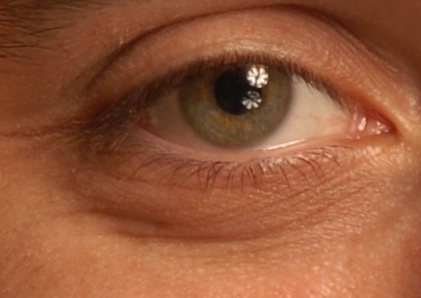 
Alfonso Alberti, solo piano Italian pianist, Alfonso Alberti presents a program of solo works for piano that explores the varied and sometimes contradictory paths travelled by contemporary music in Italy. It showcases some of the ‘main players’ in the second half of the twentieth century: Giorgio Gaslini (of whose Sonata this is the world premiere) and his ‘total music’, Sylvano Bussotti and his physical, gestural rapport with the keyboard, and Paolo Castaldi with his ‘false obviousness’. It also displays the heterodox trajectory of Michele Dall’Ongaro and the originality of the new generation: Stefano Bulfon, Silvia Colasanti, Federico Gardella, Marco Momi, and Filippo Perocco. The resulting image is an almost labyrinthine intertwining of paths which, more often than not, lead us to unimagined and surprising realms. PROGRAM Marco Momi (1978) Tre nudi (2007) Giorgio Gaslini (1929) Sonata (2012, world première) Stefano Bulfon (1975) Le temps est un fleuve sans rives (2010) Silvia Colasanti (1975) Logica in fiamme (2008) Paolo Castaldi (1930) Left (1971) Sylvano Bussotti (1931) Aquila imperiale (1986) Michele Dall’Ongaro (1957) Autodafè (cinque modi di andare alla forca) (1989) Filippo Perocco (1972) Fotogrammi (2002) Federico Gardella (1979) Di rami e radici (2009) Alfonso Alberti debuted as a pianist at the age of 17 in the Verdi Conservatory of Milan, and has been highly active ever since, playing in such varied venues as the Vienna Konzerthaus, the Teatro del Verme in Milan, and LACMA in Los Angeles as well as collaborating with various groups including the RAI (Italian national television) orches- tra. He is also a musicologist and author of several monographs on Debussy, Horowitz, Castiglione, Schoenberg and Petrassi, and is a regular contributor in scholarly publications and conferences in the field of musicology. Alfonso Alberti's appearance is made possible with support from The Istituto Italiano di Cultura San Francisco. |
|
|

Water City Berkeley: a film by Kim Anno sfSoundGroup, with musicians from Berkeley High, perform a score by composer David Coll to a film by Kim Anno. Water City Berkeley is a chapter, from Anno's Men and Women in Water Cities series, 2010-present. This staged work is about adapting to a watery world in climate change and maintaining aesthetic and intellectual life and redefining leisure time in the face of the coming disaster. Choreographer KT Nelson of the Oberlin Dance company collaborated with Anno to create a beautiful, haunting, and cryptic short film that imagines an impacted world both light and dark. The actors are mainly young people who are the inheritors of the problem from previous generations. Anno’s prior chapters are created in LA, San Diego, Miami, and Durban, South Africa, excerpts can be seen on her Vimeo channel. Kim Anno is represented by Patricia Sweetow Gallery and Marcia Wood Gallery. Her film installations have been shown Flux Projects, Atlanta, Durban Municipal Gallery, Goethe Institute, South Africa, Site Santa Fe Museum, New Mexico among other venues. Since 2011, there has been a meta project: Men and Women in Water Cities, which is a global project, with chapters filmed in northern, and southern California, Miami, and Durban, South Africa. Kim Anno has the ambition to film in a variety of port cities including island nations around the world. The multi channel film is about post sea level rise society and trying to adapt to a watery world for those in port cities and coastal areas. In Water City Berkeley, Anno is located in the city of Berkeley (which is her own municipality) and its citizens and young people (Berkeley High school); the viewers are asked to imagine a world where water has entered the city. The ocean is the mediator, the harbinger of a future town. How people will still want to be hopeful? How will they be utopian, have leisure time, work, play, make symbols, have an intellectual and aesthetic life? The role of sports is perennial, and so is art…I am picturing these qualities, and giving a snapshot of cultural life under duress. The focal point of the film is a game of "Capture The Flag", with reassembled flags suggesting that nation states have been re-formed, yet young people are still competing against one another in their highly prized leisure time. The site of the game is Alameda Beach because of its shallow nature, and actors and dancers can play out in the water away from shore enough to create a watery world illusion. The other site of film location is "The Tea House" a place (Ken Kesey hung out here) where artists and musicians have worked for several decades, inhabited by hand made sculptures, structures, and a downed glider-plane, a well worn post disaster café. Kim Anno's work has been exhibited and nationally, and internationally, and locally here in San Francisco. SFMOMA, Oakland Museum, Brooklyn Museum, and the Honolulu Academy of Fine Art have collected her work among others. Recently, she has an exhibition at Marcia Wood Gallery in Atlanta, titled "The Grand Tour" She lives and maintains a studio in Berkeley, California. The layers of meaning are both light and dark, and it is Anno's intention to spur viewers to action in whatever ways are meaningful to them. |
|
|
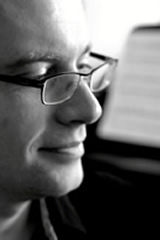
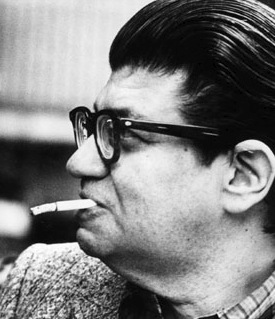
Pianist/Composer Christopher Jones performs Morton Feldman's Triadic Memories and premieres a new work. PROGRAM Morton Feldman - Triadic Memories (1981) Christopher Jones - Devil Tropes (2013 - premiere) Triadic Memories is, in practical terms, non-conceptual. It is pure music, as pure as the fugues of Bach, and completely original. One can regard its absence of foreground/background and absence of harmony as indicative of Satie and Varèse, but Feldman arrived at his conclusions independently, as they did. There is certainly no correlation between his music and the American Minimalists, such as Reich and Glass, whose works involve repetitions that are compelling in the way that popular dance rhythms are compelling. Feldman is not concerned with that kind of intertextuality, and his music is much more sublime than it is clever. He described the construction of this piece as "a conscious attempt at formalizing a disorientation of memory." If Triadic Memories were a lesser accomplishment, or just an ordinary one, it would be necessary for the listener to know what it is about in order to enjoy one's self. Listeners who come in contact with this work need not know anything about its manner of operation. Like all great art, it is a simple idea that amazes. Feldman's accomplishments rank him among the greatest of American artists from all media. -- John Keillor Christopher Jones is a composer of intricately designed music that explores issues of identity, memory and time in distinctive, unconventional ways. Christopher has presented his music in performances and lectures nationally and internationally at venues including the Darmstadt Ferienkurse in Germany, the Ictus International Composition Seminar in Brussels, Pontificia Universidad Javeriana in Bogotá, Colombia, Merkin Hall in New York and the Milwaukee Art Museum. He has worked with a broad range of ensembles and soloists such as the St. Lawrence String Quartet, the Callithumpian Consort, the sfSoundGroup, guitarist, Magnus Andersson, violinists, Janet Sung and Mark Menzies, pianist, Ann Yi and flautist, Lisa Cella. Among his honors are commissions from the Koussevitzky Foundation, three commissions from the American Composers Forum, and a Cohn Fellowship to attend the Djerassi Resident Artists Program in Woodside, CA. Also an active pianist and conductor, Christopher has a strong affinity for experimental and avant- garde music. He has given numerous premieres and has worked with composers such as Sylvano Bussotti, John Cage, Julio Estrada, Helmut Lachenmann, and Stefano Scodanibbio. He merges his interests in composition, performance and improvisation as a member of the innovative Bay Area new music group, sfSound. Currently residing in Chicago, Christopher joined the music faculty at DePaul University as Assistant Professor of Musicianship and Composition in 2011. As a long-time resident of San Francisco, he previously taught composition and music theory at Stanford, San Francisco State, and San José State Universities, and worked extensively with young composers at Lowell High School in San Francisco through a Composer-in-the-Schools residency sponsored by the American Composers Forum. He completed a doctorate in composition at Stanford University, studying principally with Brian Ferneyhough and Jonathan Harvey. He also earned degrees in composition from the University of Calgary, and piano from Indiana University and the New England Conservatory.  |
musicians | history |
sponsors | contact
Copyright © 2010 sfSoundSeries. All rights reserved.